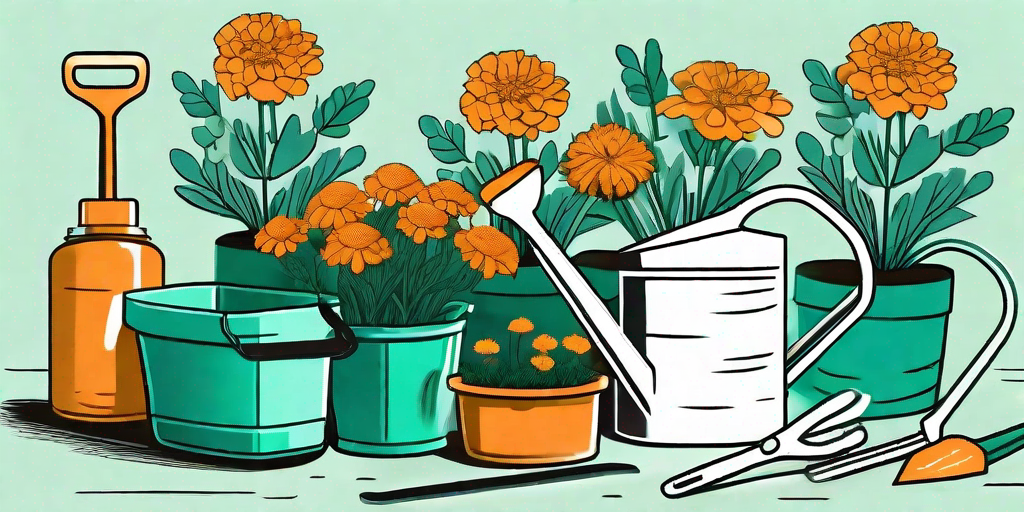
Marigolds, the vibrant, sunny flowers that grace many a garden, are known for their hardiness and easy-to-grow nature. But what happens when these usually vivacious plants start acting a bit... shy? If your marigolds are not blooming as they should, don't fret. We're here to help you troubleshoot and get your marigolds back to their blooming best.
Understanding Your Marigolds
Before we dive into the nitty-gritty of marigold care, let's take a moment to understand these plants a bit better. Marigolds, belonging to the genus Tagetes, are native to North and South America. They're known for their bright orange, yellow, and red flowers, and are a favorite among gardeners for their pest-repelling properties.
Marigolds are generally easy to grow and care for, but like all plants, they have their preferences. Understanding these preferences is key to ensuring your marigolds thrive and bloom to their full potential.
Light Requirements
Marigolds love the sun. They need at least six hours of sunlight each day to bloom well. If your marigolds are not getting enough light, they may become leggy and produce fewer flowers.
If your garden doesn't get enough sunlight, consider moving your marigolds to a sunnier spot. Alternatively, you can grow them in containers and move them around to catch the sun.
Soil and Watering Needs
Marigolds are not picky about soil, but they do prefer well-draining soil. They're drought-tolerant plants and don't like to have their roots sitting in water. Overwatering can lead to root rot, which can cause your marigolds to stop blooming and eventually die.
As a rule of thumb, water your marigolds when the top inch of soil feels dry to the touch. Be sure to water at the base of the plant to avoid getting the foliage wet, which can lead to disease.
Common Problems and Solutions
Now that we've covered the basics of marigold care, let's look at some common problems that could be causing your marigolds to be shy bloomers, and how to fix them.
Problem: Lack of Nutrients
Like all plants, marigolds need certain nutrients to grow and bloom. If your soil is lacking in these nutrients, your marigolds may struggle to produce flowers.
A balanced, slow-release fertilizer can help provide your marigolds with the nutrients they need. Be careful not to over-fertilize, though, as this can lead to lush foliage at the expense of flowers.
Problem: Pests and Disease
While marigolds are known for their pest-repelling properties, they're not immune to pests and disease. Aphids, whiteflies, and spider mites can all affect marigolds, as can diseases like powdery mildew and root rot.
Regularly inspect your marigolds for signs of pests and disease. If you spot any, treat them promptly with an appropriate pesticide or fungicide. Remember, prevention is better than cure, so keep your plants healthy and stress-free to reduce their susceptibility to pests and disease.
FAQs
- Why are my marigolds not blooming?
- There could be several reasons why your marigolds are not blooming. They might not be getting enough sunlight, they could be overwatered, or they might be lacking in nutrients. Pests and disease can also affect blooming.
- How much sun do marigolds need?
- Marigolds need at least six hours of sunlight each day to bloom well.
- How often should I water my marigolds?
- Water your marigolds when the top inch of soil feels dry to the touch. Be sure to water at the base of the plant to avoid getting the foliage wet.
- Do marigolds need fertilizer?
- While marigolds are not heavy feeders, they can benefit from a balanced, slow-release fertilizer, especially if your soil is lacking in nutrients.
Final Thoughts
Marigolds are generally easy-going plants, but even they can have their shy moments. If your marigolds are not blooming as they should, take a step back and assess their care. Are they getting enough sun? Are they being watered correctly? Are they getting the nutrients they need? Are they free from pests and disease?
With a bit of detective work and some TLC, you can get your marigolds back to their blooming best. And remember, gardening is a journey, not a destination. So, enjoy the process, learn from your mistakes, and don't be too hard on yourself (or your marigolds).
Now, go forth and help those shy marigolds bloom!















